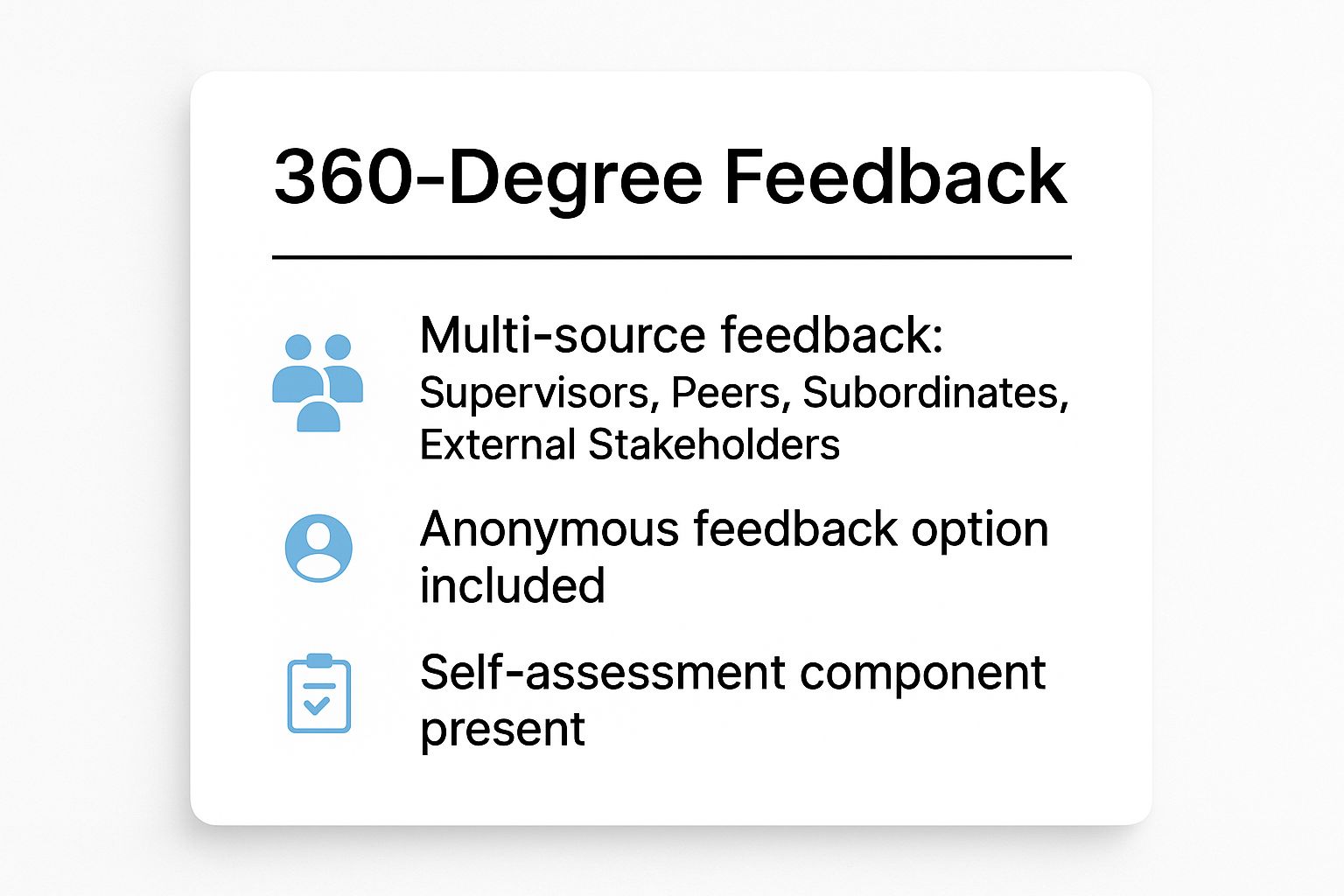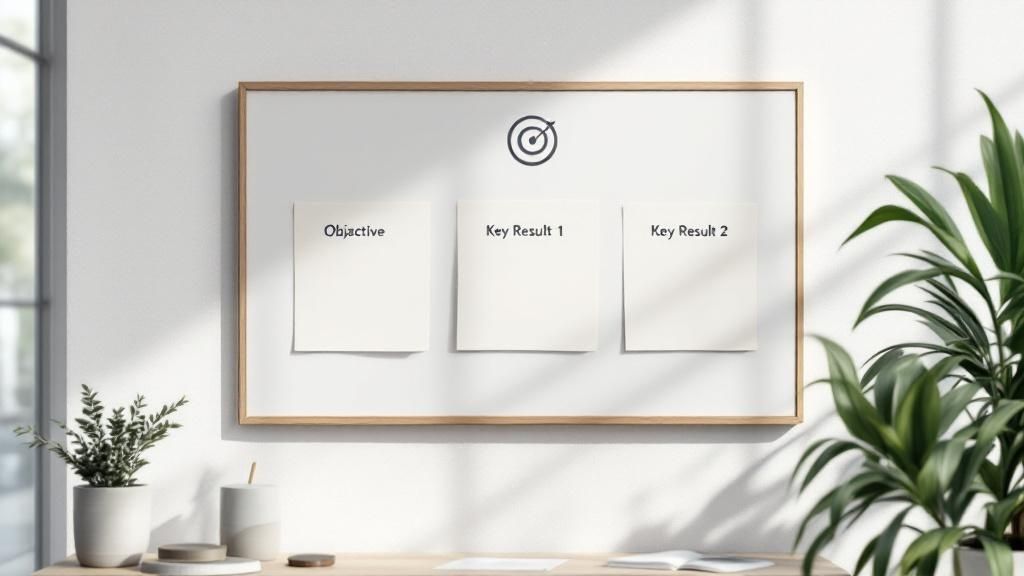Performance Review Best Practices: Boost Team Success in 2025
Discover top performance review best practices to enhance team growth and productivity in 2025. Learn how to implement effective reviews today!
For many teams, the annual performance review is a dreaded, bureaucratic ritual that feels disconnected from the day-to-day reality of work. It’s a process often filled with anxiety, recency bias, and feedback that arrives far too late to be useful. The result? A missed opportunity for genuine growth, alignment, and motivation. This backward-looking model simply doesn't meet the needs of modern, fast-paced teams, especially in startup and remote environments where agility is paramount.
This guide is designed to replace that outdated approach with a set of actionable, forward-thinking performance review best practices. We'll move beyond the once-a-year formality and explore practical strategies that foster continuous improvement and create a culture of constructive dialogue. You will learn how to implement systems like 360-degree feedback, integrate data-driven insights, and leverage strengths-based evaluations to turn reviews into a powerful tool for development.
Instead of a top-down critique, you'll discover how to build a collaborative process that truly reflects an individual's contributions and charts a clear path for their future success. These methods are designed not just to measure past performance but to actively shape and enhance future achievements, ensuring every team member is engaged, aligned, and growing.
1. 360-Degree Feedback
Traditional top-down performance reviews provide a limited, single-source perspective on an employee’s contributions. One of the most effective performance review best practices to overcome this is implementing a 360-degree feedback system. This method gathers confidential, anonymous feedback from a wide range of sources, including the employee’s manager, peers, direct reports, and even external stakeholders like clients or partners.
The goal is to provide a comprehensive, well-rounded view of an employee's skills, behaviors, and impact. By collecting diverse viewpoints, you can uncover blind spots, identify hidden strengths, and gain a more accurate understanding of how an individual collaborates and contributes to the broader organization. This holistic approach moves beyond a manager's singular opinion to create a richer, more objective assessment. For example, Johnson & Johnson's leadership assessment program uses this multi-rater feedback to develop its leaders, ensuring they receive a complete picture of their impact.
How to Implement 360-Degree Feedback
To make this process effective, structure and clarity are key. Ensure all participants, including peers and direct reports, receive training on how to provide constructive, behavior-based feedback rather than subjective personality critiques. Anonymity is also crucial; it encourages honest and candid responses that people might otherwise hesitate to share.
Here’s a summary of the core components of a successful 360-degree feedback process.

As the visualization highlights, this method integrates input from all directions, includes a self-assessment for reflection, and protects participants with an anonymous feedback option.
This multi-faceted approach provides invaluable data for personal development plans. When an employee sees consistent themes emerging from different sources, the feedback becomes more credible and actionable. For sensitive discussions, consider using a professional facilitator to help the employee process the information and create a forward-looking action plan. This transforms the review from a simple evaluation into a powerful tool for professional growth.
2. Continuous Feedback and Check-ins
The traditional annual performance review is rapidly becoming obsolete. Waiting a full year to discuss goals, progress, and areas for improvement is an outdated practice that fails to address issues in real time. A more effective and modern approach is to implement continuous feedback and regular check-ins. This model replaces the once-a-year formal review with an ongoing dialogue between managers and employees, fostering a culture of continuous improvement and agility.
The purpose is to make performance conversations a normal part of the work week, not a dreaded annual event. This practice emphasizes real-time feedback, frequent goal adjustments, and proactive development discussions. By creating this cadence, you can course-correct quickly, recognize achievements as they happen, and build stronger, more trusting relationships. This is one of the most impactful performance review best practices for dynamic teams. For instance, Adobe famously replaced its annual review with a "Check-in" system, leading to a significant drop in voluntary turnover and a more engaged workforce.

How to Implement Continuous Feedback
Successful implementation requires a shift in mindset from evaluation to development. Managers must be trained to act as coaches rather than judges, guiding their teams with timely, specific, and actionable advice. These conversations should be lightweight, forward-looking, and integrated into the natural workflow.
Here’s a summary of how to successfully integrate continuous feedback and check-ins:
- Schedule regular, recurring meetings: Establish a predictable rhythm, such as weekly 1:1s or bi-weekly check-ins, to ensure conversations happen consistently.
- Prepare talking points in advance: Both manager and employee should come prepared to discuss progress, roadblocks, and upcoming priorities. This creates a structured, productive dialogue.
- Focus on future development: While it's important to discuss past events, the primary focus should be on "what's next." Discuss career aspirations, skill development, and opportunities for growth.
- Document key decisions: Keep a lightweight record of goals, action items, and commitments to ensure accountability and track progress over time.
This approach transforms performance management from a retrospective judgment into a proactive, collaborative partnership. By making feedback a continuous and expected part of the culture, you empower employees to adapt, grow, and contribute more effectively throughout the year.
3. Goal Setting and OKRs (Objectives and Key Results)
Performance reviews often fail when expectations are unclear or disconnected from broader company goals. One of the most powerful performance review best practices is adopting the OKR (Objectives and Key Results) framework. This system links ambitious, company-wide objectives with measurable, individual key results, ensuring everyone is moving in the same direction. It transforms performance conversations from subjective assessments into objective discussions about impact.
The goal is to create a clear, transparent line of sight from an employee’s daily tasks to the organization's strategic priorities. By setting high-level objectives (the "what") and defining specific, measurable key results (the "how"), you give employees a roadmap for success. This method was famously implemented by Google to drive explosive growth and is used by companies like Spotify and LinkedIn to align their teams and foster a culture of accountability and ambition.

How to Implement Goal Setting and OKRs
Effective OKR implementation requires discipline and regular check-ins, moving reviews from an annual event to a continuous process. The framework encourages setting "stretch goals," where achieving 70% is considered a success, fostering innovation without fear of failure. This approach makes performance reviews forward-looking, focusing on growth and contribution rather than just past performance.
Here are the core components for a successful OKR process:
- Set Limited Objectives: Focus on 3-5 high-impact objectives per cycle to avoid diluting effort.
- Define Measurable Key Results: Each objective should have 3-5 specific, time-bound, and quantifiable key results.
- Cascade and Align: Goals should cascade from the company level to departments, teams, and finally, individuals, ensuring vertical and horizontal alignment.
- Review Progress Regularly: Don’t wait for the annual review. Check in on OKR progress weekly or bi-weekly to provide support and remove roadblocks.
Even with the best OKRs, most teams struggle to know whether they’re actually making consistent progress. SprintDojo solves this by combining daily win celebrations, weekly team reviews, and AI‑powered forecasting into one alignment system. Research shows small wins are the #1 motivator for sustained team performance (Amabile & Kramer, 2011), and SprintDojo builds this into your team’s daily rhythm.
4. Strengths-Based Performance Reviews
Traditional performance reviews often over-index on fixing weaknesses, which can be demotivating and lead to only incremental improvements. A more powerful approach is to implement strengths-based performance reviews. This best practice, popularized by researchers at Gallup, shifts the focus from correcting deficiencies to identifying, developing, and leveraging an employee’s natural talents.
The goal is to align what people do best with the work they are assigned, maximizing engagement and performance. By concentrating on strengths, you empower employees to achieve excellence rather than just mediocrity. For instance, Best Buy famously shifted its talent development to a strengths-based model, resulting in higher employee engagement and measurable improvements in business outcomes. This approach recognizes that investing in a person's inherent talents yields a far greater return than trying to fix their inherent weaknesses.
How to Implement Strengths-Based Performance Reviews
Successfully adopting this model requires a structured process for identifying and applying employee strengths. The conversation must move from "What did you do wrong?" to "How can we create more opportunities for you to use your best talents?" This requires managers to act more like coaches than critics, guiding team members toward roles and projects where they can excel.
Here are the core components of a successful strengths-based review:
- Utilize a Validated Assessment: Start with a tool like Gallup's CliftonStrengths to provide a common, objective language for discussing talents.
- Focus on Strength Application: Dedicate review conversations to exploring how an employee’s top strengths were applied in past projects and how they can be used more effectively in future ones.
- Align Roles and Projects: Actively look for ways to adjust responsibilities to better match an employee's identified strengths, turning their job into a role they are naturally wired to succeed in.
- Address Weaknesses Strategically: Weaknesses should only be addressed if they are critical to the role and directly hinder an employee's ability to use their strengths. The solution might involve a workaround or partnership, not just forced improvement.
This method transforms the performance review from a remedial exercise into an inspiring and forward-looking strategic conversation. It builds confidence and creates a culture where employees feel valued for their unique contributions, directly boosting both individual and team performance.
5. Self-Assessment Integration
Often, performance reviews can feel like a one-sided conversation where a manager delivers a verdict. Integrating employee self-assessments is a powerful best practice that transforms this dynamic into a collaborative dialogue. This approach requires employees to reflect on their own performance, accomplishments, challenges, and development goals before the formal review meeting, ensuring they come prepared and engaged.
The primary goal is to empower employees to take ownership of their career development and performance narrative. By prompting them to analyze their contributions and areas for growth, you foster self-awareness and accountability. This proactive step ensures the subsequent conversation with their manager is richer, more balanced, and focused on alignment rather than just evaluation. For instance, Salesforce’s V2MOM (Vision, Values, Methods, Obstacles, Measures) framework encourages employees to regularly self-assess their progress against clear goals, making the formal review a natural extension of an ongoing process.
How to Implement Self-Assessment Integration
To make self-assessments meaningful, you must provide clear guidelines and thoughtful prompts. Employees need to understand that this is not just a formality but a critical input to their performance discussion. The questions should encourage specific, evidence-based reflection rather than vague, general statements.
Here’s a summary of the core components for a successful self-assessment process:
- Provide Clear Guidelines: Give employees a structured template or form with specific questions covering achievements, challenges, learnings, and future goals.
- Encourage Data-Driven Reflection: Ask employees to support their reflections with concrete examples, metrics, and project outcomes.
- Ask Forward-Looking Questions: Go beyond past performance and ask about career aspirations, desired skills, and what support they need to succeed.
- Use it as a Foundation: The manager should review the self-assessment before the meeting to identify areas of agreement and divergence, using it to guide the conversation.
This process gives employees a voice and ensures that their perspective is heard and valued. When a manager can directly compare their evaluation with the employee's self-assessment, it provides a clear framework for a productive discussion about perception gaps, shared successes, and future priorities. This transforms the review from a top-down critique into a collaborative planning session for future growth.
6. Behavioral and Competency-Based Evaluation
Focusing solely on completed tasks or "what" an employee achieves can miss a critical part of the performance equation: "how" they achieve it. A behavioral and competency-based evaluation provides a systematic framework for assessing the specific, observable behaviors that drive success. This method moves beyond simple output metrics to evaluate an employee against the core competencies required for their role and the organization's culture.
The goal is to create a clear, objective standard for performance that connects an individual's actions to business outcomes. By defining what successful behavior looks like, you provide employees with a roadmap for development and a consistent rubric for evaluation. For instance, Amazon famously evaluates all employees, from junior staff to senior leaders, against its 14 Leadership Principles. This ensures that behaviors like "Customer Obsession" and "Bias for Action" are consistently measured and reinforced across the company.
How to Implement a Behavioral and Competency-Based Evaluation
Success with this method depends on clearly defined standards and consistent application. Vague competencies are ineffective; instead, each one should be supported by specific, observable behavioral examples. For instance, a competency like "Team Collaboration" could be broken down into behaviors such as "proactively shares information with colleagues" or "actively listens and incorporates diverse viewpoints in meetings."
Here’s a summary of the core components for a successful implementation:
- Define Core Competencies: Identify the key skills, knowledge, and behaviors required for success in different roles and at your organization.
- Create Behavioral Indicators: For each competency, list concrete examples of effective (and ineffective) behaviors.
- Train Managers and Employees: Ensure everyone understands the competencies and how they will be evaluated.
- Integrate into Performance Cycle: Use the competency model for goal setting, feedback discussions, and development planning.
This approach provides a more balanced and fair assessment, as it focuses on observable actions rather than subjective traits. To effectively evaluate behavioral competencies, understanding various assessment approaches can be beneficial; for example, insights gleaned from resources on structured behavioral interview questions and answers can inform performance discussions. By making competencies central to your performance review best practices, you align individual behavior with organizational values and create a culture of predictable excellence.
7. Data-Driven Performance Analytics
Relying solely on subjective manager observations can lead to biased and inconsistent performance evaluations. One of the most impactful performance review best practices is to integrate data-driven performance analytics. This approach uses quantitative data from various business systems to create a more objective, evidence-based picture of an employee’s contributions, patterns, and impact over time.
The goal is to move beyond gut feelings and anchor conversations in measurable outcomes. By leveraging technology and data, you can track key performance indicators (KPIs), project completion rates, sales figures, or customer satisfaction scores. This provides a clear, factual basis for discussion, reducing the influence of recency bias or personal opinions. Google’s People Analytics team, for instance, famously uses data to understand what makes managers effective, proving that evidence-based insights lead to better leadership and team performance.
How to Implement Data-Driven Performance Analytics
To adopt this practice effectively, the focus must be on relevance and balance. The metrics chosen should directly align with an employee’s role and the company’s strategic goals. It's also critical to remember that data tells only part of the story; it should be used to inform, not dictate, the entire performance conversation.
Here are the core components for implementing data-driven analytics successfully:
- Balance Quantitative and Qualitative Insights: Use metrics to highlight what happened, but rely on conversation to understand the why and how.
- Ensure Data Accuracy and Relevance: Pull data from reliable sources and ensure the chosen metrics are a true reflection of performance for that specific role.
- Train Managers on Data Interpretation: Equip leaders with the skills to read, interpret, and discuss data constructively, avoiding a purely punitive approach.
- Use Multiple Data Sources: Combine data from different systems (CRM, project management tools, HRIS) for a comprehensive and balanced view.
This evidence-based approach helps identify high-performers, pinpoint skill gaps, and make fairer decisions about promotions and compensation. When managers and employees can review objective data together, the conversation shifts from a subjective critique to a collaborative problem-solving session focused on future growth.
Best Practices Comparison Table
| Method | Implementation Complexity 🔄 | Resource Requirements ⚡ | Expected Outcomes 📊 | Ideal Use Cases 💡 | Key Advantages ⭐ |
|---|---|---|---|---|---|
| 360-Degree Feedback | High - requires coordination & trust | High - multiple raters, training | Holistic view, blind spot identification | Leadership development, comprehensive reviews | Reduces bias, encourages self-awareness |
| Continuous Feedback & Check-ins | Medium - needs cultural shift | Medium - frequent manager time | Real-time adjustments, improved engagement | Fast-paced environments, ongoing development | Prevents surprises, quick course correction |
| Goal Setting and OKRs | Medium - structured goal cycles | Medium - regular tracking tools | Aligned goals, measurable progress | Strategy alignment, performance transparency | Clear metrics, ambitious goal-driving |
| Strengths-Based Reviews | Medium - requires trained managers | Medium - assessment tools needed | Increased engagement, maximized potential | Talent development, positive review culture | Focus on strengths, boosts satisfaction |
| Self-Assessment Integration | Low to Medium - requires guidance | Low - employee time investment | Increased ownership, more complete reviews | Employee development, paired with other methods | Encourages self-awareness, highlights achievements |
| Behavioral & Competency Eval. | High - development of frameworks | High - evaluator training needed | Fair, consistent, skill-focused assessments | Roles needing specific competency validation | Reduces bias, clear expectations |
| Data-Driven Performance Analytics | High - needs tech & data systems | High - analytics tools and support | Objective insights, trend detection | Large organizations, evidence-based decisions | Concrete evidence, benchmarking capability |
From Annual Chore to Strategic Advantage
The era of the once-a-year, top-down performance review is over. Treating this critical process as a mere administrative chore is a missed opportunity of immense proportions. As we've explored, modernizing your approach transforms the review from a source of anxiety into a powerful engine for growth, alignment, and sustained team motivation. The performance review best practices detailed in this guide are not just isolated tactics; they are interconnected components of a holistic talent development ecosystem.
Moving forward, the goal is to weave these elements into the very fabric of your company culture. It’s about creating a system where feedback is a continuous, multi-directional conversation, not a dreaded annual event. By integrating 360-degree feedback, you build a culture of shared accountability. By embracing frequent check-ins, you make coaching and course-correction a natural part of the weekly rhythm. And by grounding everything in clear, ambitious OKRs, you ensure every individual effort is directly tied to the company's most important objectives.
Key Takeaways for Immediate Action
To transition from theory to practice, focus on these pivotal shifts:
- Move from Event to Process: Your biggest takeaway should be this: performance management is not a meeting. It’s a continuous cycle of goal-setting, feedback, coaching, and recognition. Ditch the "once-and-done" mindset forever.
- Emphasize Strengths and Data: Shift the conversation from "what went wrong" to "how can we amplify what's working?" Use strengths-based evaluations and data-driven insights to foster positive development and make objective, evidence-based decisions.
- Empower the Employee: Integrate self-assessments and behavioral evaluations to give team members ownership over their growth. When employees are active participants in their own review, their engagement and commitment skyrocket.
Building a High-Performance Culture from Day One
Ultimately, the most effective performance review system is one that complements a strong foundation of talent acquisition. After all, developing great employees starts with hiring them. A truly strategic approach to talent management also considers initial hiring strategies; for a broader view on building an effective workforce, explore additional recruitment best practices to ensure you bring in the right talent from the start.
By adopting these modern performance review best practices, you are investing in your most valuable asset: your people. You’re building a workplace where employees feel seen, valued, and empowered to do their best work. This isn't just about better reviews; it's about building a resilient, high-performing organization that can navigate any challenge and seize every opportunity. The path from a bureaucratic necessity to a true strategic advantage is clear, and it begins with the commitment to making every conversation count.
Sprint Smarter. Forecast Every Week.
Log wins. Build momentum. Let AI show you if you're on track to hit your sprint goal—before it's too late.
Join the waitlist and be the first to unlock predictive clarity for your team.

